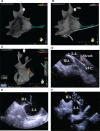The Grand SANS FLUORO (SAy No Series to FLUOROsopy) Study: Examining Fluoroscopy Use in More than 1,000 Ablation Procedures
- PMID: 32983591
- PMCID: PMC7510468
- DOI: 10.19102/icrm.2020.1100903
The Grand SANS FLUORO (SAy No Series to FLUOROsopy) Study: Examining Fluoroscopy Use in More than 1,000 Ablation Procedures
Abstract
The majority of electrophysiologists routinely use fluoroscopy (FLUORO) during ablation procedures for common arrhythmias despite the known complications of radiation exposure and protective lead use. This study assessed the safety of catheter ablation (CA) with FLUORO versus without FLUORO (SANS FLUORO) in patients with the following common arrhythmias: atrial fibrillation (AF), atrial flutter, supraventricular tachycardia, and ventricular tachycardia. A total of 1,258 CA procedures were performed in 816 consecutive patients over a 53-month period (SANS FLUORO CA: 609 patients; FLUORO CA: 209 patients). The secondary outcome was the efficacy of AF ablation in FLUORO versus SANS FLUORO patients. Ultimately, there was no statistically significant difference found concerning the safety of CA in the SANS FLUORO and FLUORO groups in terms of procedure time, vascular complications, tamponade, stroke, or death. FLUORO patients had markedly increased FLUORO time, increased radiation exposure, and increased dose-area product (all p < 0.0001). AF development after SANS FLUORO CA of AF was not different from that after FLUORO CA regardless of the pulmonary vein isolation (PVI) modality used (cryoablation versus radiofrequency) at 24 months (p = 0.21). Additionally, women fared just as well as men after CA ablation for AF. At 36 months, 58% of SANS FLUORO AF device patients were free from AF. As such, SANS FLUORO CA of common arrhythmias appears to be as safe as FLUORO CA but with a markedly reduced level of radiation exposure. Also, SANS FLUORO CA remains as effective as FLUORO CA in the prevention of AF for up to 24 months.
Keywords: Ablation; arrhythmia; atrial fibrillation; fluoroscopy; three-dimensional mapping.
Copyright: © 2020 Innovations in Cardiac Rhythm Management.
Conflict of interest statement
Dr. Percell reports that he is on speaker bureaus for Abbott Medical, Biosense Webster, Janssen, Pfizer, and Boehringer Ingelheim, outside the scope of the submitted work. The other authors report no conflicts of interest for the published content.
Figures





References
-
- Mujović N, Marinković M, Lenarczyk R, Tilz R, Potpara TS. Catheter ablation of atrial fibrillation: an overview for clinicians. Adv Ther. 2017;34(8):1897–1917. [CrossRef] [PubMed] - DOI - PMC - PubMed
-
- Narang A, Sinha SS, Rajagopalan B, et al. The supply and demand of the cardiovascular workforce: striking the right balance. J Am Coll Cardiol. 2016;68(15):1680–1689. [CrossRef] [PubMed] - DOI - PMC - PubMed
-
- Luani B, Rauwolf T, Genz C, Schmeißer A, Wiemer M, Braun-Dullaeus RC. Intracardiac echocardiography versus fluoroscopy for endovascular and endocardial catheter navigation during cryo-ablation of the slow pathway in AVNRT patients. Cardiovasc Ultrasound. 2019;17(1):12. [CrossRef] [PubMed] - DOI - PMC - PubMed
-
- Reddy VY, Morales G, Ahmed H, et al. Catheter ablation of atrial fibrillation without the use of fluoroscopy. Heart Rhythm. 2010;7(11):1644–1653. [CrossRef] [PubMed] - DOI - PubMed
-
- Ferguson JD, Helms A, Mangrum JM, et al. Catheter ablation of atrial fibrillation without fluoroscopy using intracardiac echocardiography and electroanatomic mapping. Circ Arrhythm Electrophysiol. 2009;2(6):611–619. [CrossRef] [PubMed] - DOI - PMC - PubMed
LinkOut - more resources
Full Text Sources
Research Materials
